Salute to Charlie Chaplin
Written and Illustrated by Bruce “Charlie” Johnson, WCA
Historian
The year
2014 is the centennial of the creation of Charlie Chaplin’s Little Tramp.
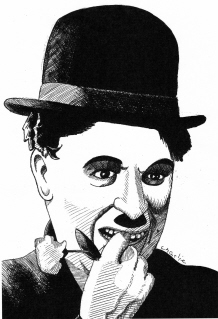
Kid Auto
Races in
Venice, CA,
Charlie Chaplin’s first appearance as the Little Tramp, was released
February 7, 1914.
Chaplin is often quoted as saying that as soon as he donned the costume
for this short film he understood the character.
He may have thought he understood the character, but his early films show
that 1914 was a year of experimentation.
He made 35 films during the year that he spent at the Keystone studios.
He did not use the tramp character in all of them.
When he did dress as the tramp there was not yet a consistent character.
Sometimes the tramp was mean and angry, qualities that would disappear
during his most artistic period.
Actually his character continued to evolve during his career.
There is a
debate over whether Chaplin is technically a clown.
I consider him as one because he consistently performed one well defined
comedy character, used an exaggerated make up (his moustache was painted on or
an artificial one) and costume, and created most of his own material. Those who
seek to exclude him from consideration as a clown often do so because movies
were his primary venue. Whether he was actually a clown or not is unimportant.
He had a tremendous influence upon entertainment and the art of clowning.
While he
was an influence on others, he was also influenced by others.
Like any entertainer, he did not create his art in isolation.
Chaplin’s Influences
Charlie
Chaplin (1889-1977) developed his physical comedy skill while performing with
the Karno Pantomime troupe. It is
important to realize that the word Pantomime in the group’s name does not have
the modern American definition of silent acting.
The Karno troupe was from
England
where Pantomime was a specific type of stage show most closely associated with
Christmas and Easter celebrations. A
Pantomime was a fast-paced spectacle with knock-about comedy, verbal humor, and
topical gags. The Karno scripts
included dialogue and songs. British
audiences would have expected the Karno troupe’s wild comedy based on the title.
American audiences may not have had the same understanding when the group
toured the
United States.
Fred
Karno was a comedian and producer of comedy acts.
He wrote acts, cast young entertainers who he trained, and booked the
acts on tour. Sydney Chaplin,
Charlie’s older brother, joined the Karno company in 1906, and recommended that
Karno hire Charlie in 1908. Another
member of the company was Stanley Jefferson, who would later adopt Stan Laurel
as his stage name. Glenn Mitchell
quotes Stan telling his biographer, John McCabe, “Fred Karno didn’t teach
Charlie and me all we know about comedy.
He just taught us most of it.”
According to
Laurel,
Chaplin was “the most supple, precise comedian of our time” due to Karno’s own
performance ability that he passed on, and his insistence on precision brought
about by constant rehearsal and performances. 1
According
to Glenn Mitchell, “He (Karno) was also responsible, at least in part, for
Chaplin’s blend of laughter and pathos, exhorting his comics to ‘keep it
wistful… we want sympathy with the
laughter.’” 2
Charlie Chaplin was not the first to portray a tramp character.
The earliest performance of a tramp character I have found is Jim
McIntyre and Tom Heath who began their long running tramp act in 1874.
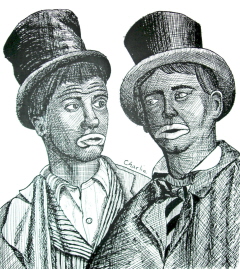
McIntyre and Heath
McIntyre
and Heath may have been an influence upon Chaplin who made his first trip to
America
with the Karno Pantomime troupe in 1910.
An article in the
October 4, 1910
issue of the
New York Times lists McIntyre and Heath headlining the
vaudeville bill at Hammerstein’s
Victoria
Theatre
and the Karno Pantomime troupe performing “A Night in a London Secret Society”
as one of the novelty acts at the Colonial theater.
Although there is no record of Chaplin seeing McIntyre and Heath in
performance it is possible. He
certainly would have been aware of their famous act due to the publicity and
reviews when they were all performing in
New York.
While Chaplin is not mentioned by name in the October 4th article, the
author says McIntyre and Heath “supplied twenty minutes of constant merriment.”
Chaplin’s
two tours of
America
with the Karno Pantomime troupe occurred during the height of tramp clown
popularity which stretched from 1890 to 1916, when
America
entered World War I. Bert Williams
had been performing his tramp act in vaudeville, and joined the Ziegfield
Follies in 1910. W.C.Fields toured
internationally as the Great Tramp Juggler before dropping his tramp appearance
in 1912. Robert Clark and Paul
McCullough performed as silent tramp clowns in 1912 before developing their
famous rapid fire vocal routines.
Lew Bloon, Nat Wills, James Harrigan, George Rowland, Paul Barnes, and Charles
R. Sweet were very popular tramp clowns performing in vaudeville during this
era. It is possible that Chaplin saw
some of these performers while touring in American vaudeville.
(Laurel
certainly did. John McCabe’s
The Comedy World of Stan Laurel
has a photo of a young
Laurel
imitating “one of his idols, Nat Wills, vaudeville’s ‘Happy Tramp.’”
The same book has a photo of
Laurel
performing with Arthur Dandoe in 1912 between tours with Karno.
Dandoe is wearing tramp clown make up. 3)
These performers definitely created an acceptance of tramps as comedy
characters that paved the way for the popularity of Chaplin’s films.
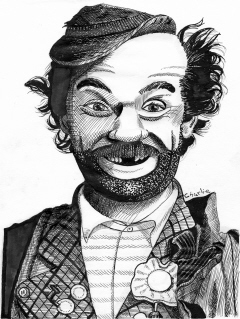
Nat Wills - The Happy Tramp
An
acceptance of tramps had to be created because during the depression following
America’s
Civil War real tramps were feared and hated.
Newspaper editorials advocated poisoning food given to vagrants and
Pinkerton guards killed tramps found riding trains.
According
to John Towsen, “In the early
twentieth century, mixed feelings of envy and guilt on the part of more
respectable and prosperous Americans elevated the once despised tramp to the
level of philosophical vagabond and folk hero.
He became known to millions through the comic strips in their local
newspapers. Opper’s cartoon
character, ‘Happy Hooligan’, and Zim’s Hoosier tramp, ‘Weary Willy’, conformed
to the new image of the tramp as a harmless eccentric, more to be pitied than
feared.” 4
Happy
Hooligan, a comic strip by Frederick Burr Opper, debuted in the
New
York Journal on
March 11, 1900,
and ran until
August 14, 1932.
Happy Hooligan was the first major cartoon character to be the victim of
comic violence instead of its instigator.
He was a good-hearted failure and generous soul whose attempts to be
helpful backfired because he was misunderstood.
Often the person he tried to assist ended up attacking him.
Opper referred to Happy Hooligan as “a favorite son of misfortune.”
In Chaplin’s earliest films, he was the aggressor.
However, as his character developed it began to take on more of the
qualities of Happy Hooligan. Happy
Hooligan is possibly another source of the pathos that would be an important
part of Chaplin’s success. According
to Richard Marshall, “Not only did he (Opper) adapt to several trends in
American humor, but he largely helped define them.
His slapstick and his tramp hero may very possibly have been responsible
for the figures which evolved into W.C. Field’s Tramp Juggler (the comedian’s
first persona) and Charlie Chaplin’s Tramp; at the very least Happy Hooligan
created a climate receptive to such characters.”
Mabel
Normand was an important influence upon Chaplin.
According to some accounts she is the one who discovered him.
After seeing him perform with the Karno Pantomime troupe she convinced
Mack Sennet to offer the young comedian a film contract at Sennet’s Keystone
studio. She was already an
established movie star when Chaplin began his film career and was an
accomplished comedy creator. She is
credited with creating the Keystone Kops and throwing the first pie in the face.
Normand appeared with Chaplin in many of his early films and directed
some of them. Her importance is
indicated in the titles of some of Chaplin’s films at Keystone.
He appeared in “Mabel’s Strange Predicament”, “Mabel at the Wheel”,
“Mabel’s Busy Day,” and “Mabel’s Married Life”.
He was almost fired when he quarreled with her direction in “Mabel at the
Wheel”. However, a telegram from a
film distributor requesting more of the popular Chaplin movies convinced Sennett
to keep Chaplin under contract.
Normand and Chaplin received credit as co-directors on some of his films, and
then he took over solo direction. He
learned a lot about movie comedy and direction from Normand.
When
Mack Sennett decided to produce the first feature length comedy film in
America,
he felt that none of his established stars were popular enough to fill theaters.
So he hired Marie Dressler, the most famous comedienne in
America
at the time, to star in “Tillie’s Punctured Romance”, a film based on a
character she played in her Broadway shows.
Charlie Chaplin and Mabel Normand were cast in supporting roles in the
film. Chaplin had been concentrating
on developing his Tramp character and learning the art of directing, but this
film required him to play a different character directed by Sennett himself.
However, the international fame that resulted from Chaplin’s role in this
film released on
November 14, 1914
brought him to the attention of other producers.
By
the end of November 2014, Chaplin signed a contract with Essanay studios.
Chaplin made two more short films to complete his Keystone contract, and
moved to the Essanay studios in
Chicago
early in 1915. Starting with his Essanay contract, Chaplin was in charge of his
films. When he worked for other
studios, he had his own unit within the studio.
Eventually he opened his own studio.
Chaplin
had started 1914 with no understanding of the film business, but the year was
one of tremendous growth and learning.
Starting the next year he had a tremendous impact on entertainment.
Chaplin’s
Influence
Stan
Laurel
When
Chaplin toured
America
with the Karno Pantomime troupe, his room mate and understudy was Stanley
Jefferson. (Jefferson eventually adopted Stan Laurel as his stage name.)
When Chaplin left the group, Stan took over his role as “the Drunk” and
did a perfect imitation of Chaplin.
The American troupe soon disbanded, and
Laurel
decided to stay in
America.
In 1915, after Chaplin’s Keystone comedies had become enormously popular,
Laurel toured vaudeville in an act called the Keystone trio.
In the act,
Laurel
impersonated Chaplin’s tramp, while Edgar Hurley imitated Chester Conklin, and
Wren Hurley imitated Mabel Normand.
The act lasted less than a year, but it introduced him to a “big time” booking
agent who would continue to find work for him with other partners.
Over the years
Laurel
experimented with different characters, and even abandoned performing to become
a writer. Eventually he was teamed
with Oliver Hardy, created his own unique character, and made his own important
contributions to comedy.
Walt
Disney
Chaplin’s
popularity inspired many imitators.
When Walt Disney’s family moved to
Kansas City
while he was in grade school, Disney became friends with a neighborhood boy
named Walt Pfeifffer. Disney and
Pfeiffer developed an act they called the “Two Bad Walters” which they began
performing at school and then in amateur contests.
At first they performed as “Dutch” comics.
However, they became more successful when Disney began impersonating
Chaplin, and Pfeiffer played Chaplin’s nemesis, a character that they called the
Count. When each Chaplin film was
released they would see it several times and then discuss his technique.
Disney learned to copy many of Chaplin’s moves including tossing a
cigarette over his shoulder and then kicking it behind him.
Disney said, “We always got a little more applause than someone else
imitating Chaplin because we were younger and it was a team of us… (Those
performances) reacted on me like the taste of blood on a lion.
In other words, I liked acting!
Liked the applause, liked the cash prizes that were being handed to us,
liked the weird smells and weirder sights behind the scenes.” 5
Disney’s
experience imitating Chaplin had a profound impact on the rest of his life.
First, it inspired an interest in being an entertainer.
Second, it taught him comedy structure and how to create an act.
Third, it taught him to be an actor.
Disney’s
other interest was drawing, which led him into the animation branch of
entertainment where he used the skills he had developed as a youngster.
In giving direction to the animators at his studio, Disney would act out
the actions for the cartoon characters.
(He played all the roles in acting out the story of Snow White and the
Seven Dwarves for his animators before any work was done on the film.)
The animators would base their drawings on his acting.
He used the knowledge he developed by performing and watching other acts
in the shows to structure the cartoons.
He also became a voice over actor by performing the voice of Mickey Mouse
for his cartoons.
Former
circus and vaudeville clown Pinto Colvig, who also became a voice over artist
and gag writer at the Disney Studios, said, “A cartoonist is a clown with a
pencil.”
I
have learned a lot about comedy structure and movement by studying the Disney
animated films. I know many other
clowns who have also learned from the films.
They all started with Disney’s experience imitating Chaplin.
Harold
Lloyd
When
Harold Lloyd (1893 – 1971) broke into the movies as a young comedian he decided
he did not want to imitate Chaplin.
In describing the creation of his Lonesome Luke character, Lloyd said, “My
father had found a worn pair of Number 12AA shoes in a repair shop… In a
haberdashery Dad found a black-and-white vertical striped shirt and bought out
the stock. The coat of a woman’s
tailored suit, a pair of very tight and short trousers, a vest too short, a
cut-down collar, a cut-down hat and two dots of a mustache completed the
original version of Lonesome Luke.
The cunning thought behind all of this, you will observe, was to reverse the
Chaplin outfit. All his clothes were
too large, mine all too small. My
shoes were funny, but different; my mustache funny, but different.
Nevertheless, the idea was purely imitative and was recognized as such by
audiences, although I painstakingly avoided copying the well-known Chaplin
mannerisms.” 6
Lloyd’s
Lonesome Luke films were successful, but did not equal the popularity of
Chaplin’s films. His reverse imitation of Chaplin did not work because Lloyd’s
choices were still dictated by Chaplin.
However, Lonesome Luke gave Lloyd something to perform while developing
his skills and learning the motion picture business.
Lloyd said he particularly had a difficult time learning timing,
something he considered Chaplin to have mastered.

Harold Lloyd who was initially inspired by Chaplin, but whose
thrill comedies later inspired Chapliln.
Eventually
Lloyd ignored Chaplin and created his own “glasses character” that was an
expression of his personality. Then
he reached his potential. Chaplin,
Lloyd, and Buster Keaton are often referred to as the three Kings of Silent Film
Comedy. In some years, Lloyd’s films
were more popular than Chaplin’s.
Viewing the feature films of all three stars reveals that they inspired and
influenced each other. For example,
the high wire scene in Chaplin’s “The Circus” was inspired by Lloyd’s very
popular thrill comedies. Lloyd
continues to influence clowns today.
Topical
Routines
Chaplin
had a tremendous influence upon circus clowns who frequently perform topical
routines inspired by current events and pop culture.
According
to a Billboard magazine review of the 1915
Sells Floto Circus, Carlton Emery did a walkaround listed as “Made in
America Charlie Chaplin.”
A
Barnum & Bailey Circus poster depicting clowns in 1916 included a
Chaplin impersonator. (Note: Circus
posters were not always accurate.
Sometimes the poster artist created their own vision of a show before seeing the
actual performers.)
John
Towsen refers to Frankie Saluto performing as a miniature version of Charlie
Chaplin. I don’t know during what
season this occurred. 7

Dwarf clown Frankie Saluto
The
running order for the 1942
Holland Classical Circus (actually an American show) lists act
#12 as “Trampoline act with Adriana and Charles, Charles performed comedy in
Charlie Chaplin make up and costume.”
Charlie Rivel
Pepe
Andreu (1896-1980) grew up performing with his large family in circuses.
In 1915 his father began his own show in
Spain
titled Circo Reina-Victoria (The
Queen Victoria Circus). In
1916, Pepe created a parody of Charlie Chaplin performed on a trapeze.
It was originally billed as ‘Pepe Andreu in his great Charlot-entrance
and the Astonishing Charlot Imitation.”
(Charlot is the European version of Charlie.)
In his autobiography, Rivel claims that he entered a Charlie Chaplin look
alike contest and took first place.
The person who came in second was the real Charlie Chaplin who entered under a
false name. 8
According
to Rivel’s autobiography, Chaplin sued Rivel claiming his impersonation was
plagiarism. However, the judge ruled
that Rivel’s trapeze act was actually a brilliant parody. Legally there is a
fine line between plagiarism, which is illegal, and parody, which is protected
by free speech doctrines.
Most of
the acts in the
Circo Reina-Victoria were performed by family members so the
name Andreu appeared many times in the circus program.
It is common for circus performers to use a different stage name for each
of their acts to make the cast seem larger and more varied.
Pepe Andreu decided to use a different name while performing his Charlie
Chaplin parody. By combining letters
at random he settled on Rivel as his new last name.
He decided to change Charlot to the English version.
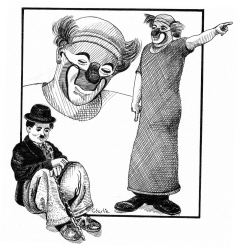
Charlie Rivel performed a Chaplin parody on the trapeze, and
used an Auguste make up for his other acts.
He also
used Charlie Rivel as his clown name when he performed entrée acts with his
brothers. He developed a second
clown character, an Auguste with a distinctive square nose.
He continued performing his Chaplin on the Trapeze act and his Auguste
clown acts throughout most of his career.
He became internationally famous as Charlie Rivel and was inducted into
the International Clown Hall of Fame in 1999.
Karandash
Stars
of silent films produced in
America
became international celebrities because there was no language barrier.
In order to export a film to a foreign market the producer simply had to
replace a few title cards translated into another language.
Following
the Russian Revolution clowns in the new
Soviet Union
searched for a more culturally relevant form of clown.
Many of them copied Chaplin.
Karandash (Michael Rumyantsev) (1907 --
), the Father of Soviet Clowning, started as a Chaplin imitator.
Eventually his appearance evolved to be even more reflective of the
common Soviet citizen. Karandash was
tremendously influenced by American silent films.
His most famous routine, the Mismade Statue, was inspired by a 1929
Laurel
and Hardy film titled “Wrong Again”.

Karandash performing his break away statue routine
Emmett Kelly
Emmett
Kelly (1898 --1979) didn’t imitate Chaplin, but he was inspired by him.
Emmett
Kelly’s daughter, Monika, told me, “Daddy admired him (Chaplin) for his work in
silent films and his ability to convey without speaking.”
In
a 1976 interview with UPI writer David L. Langford, Emmett Kelly said, “I think
he (Chaplin) was the greatest pantomime artist we have ever known.
He makes us laugh. You don’t
laugh at Marcel Marceau, the French mime… I had the presence of mind to copy his
mannerisms. I even thought of using
a cane, but I decided everyone would think I was aping him.”
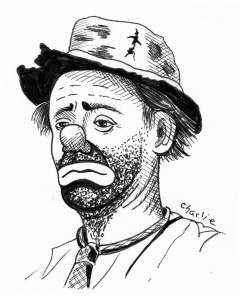
Emmett Kelly
I never
watched Kelly’s performances as his character Weary Willy and thought he was
copying Chaplin. One thing Weary
Willy and Chaplin’s Little Tramp both had in common was the combination of humor
and pathos. People were sympathetic
towards Weary Willy. According to
Kelly’s autobiography this led to one of his most famous routines.
A circus patron gave Willy a roasted peanut.
Looking around for something to use to crack the peanut, Kelly spotted a
sledge hammer used for pounding stakes holding rigging.
He tried to tap the peanut gently, but the hammer was so heavy it
completely smashed the shell and the kernel inside.
His reaction to his failure brought great audience response.
Kelly turned the impromptu bit into a regular part of his repertoire.
9
Many
clowns, including me, were inspired by Kelly.
So, like ripples expanding in a pond, Chaplin’s influence upon Kelly grew
through Kelly’s influence on others.
Doug
Ashton
Doug
Ashton, a descendant of
Australia’s
famous Ashton circus family, was an early graduate of the
Ringling Bros. and Barnum & Bailey Clown College™.
He toured with the
Ringling Bros. and Barnum & Bailey Circus™
in the 1970’s performing as a Chaplin type clown.
He was not an exact copy, but his source of inspiration was obvious.
His make up, costuming, and style of movement made him stand out from the
rest of the clown alley and he became very well known.
After
he left the
RBB&B Circus, I saw him perform his very funny solo clown act as
part of a one-ring circus that was a summer feature at Knott’s Berry Farm during
the early 1980’s.
Tributes
Early
in my career, after I had already chosen Charlie as my clown name, I was told
that all tramp clowns in
Europe are referred to as Charlie in honor of Chaplin.
I have not confirmed if that is true.
In
recognition of his contributions to the art of clowning Charlie Chaplin was
inducted into the International Clown Hall of Fame in 2001.
Conclusion
Because
of his popularity and influence many books have been written about Charlie
Chaplin. His films are available in
many
DVD
sets making them available for our study.
I invite you to celebrate this centennial year of Chaplin’s Little Tramp
by watching some of his films and reading more about him.
Chaplin’s
popularity spawned imitators. Many
entertainers learned principles of clowning through the imitation, but then
achieved success by applying what they learned to create their own unique
characters. I don’t advocate
plagiarism among clowns, but it is okay to learn by copying standard routines.
However, to reach your potential you need to move beyond that.
Who has been an influence upon you?
What have you learned from them?
How can you apply that to create something new?
If
Chaplin has been an influence upon you, I invite you to share with other WCA
members what you learned from him and how you have applied that to your
clowning. WCA Alleys can have a
tribute at one of your meetings by sharing memories about seeing his films and
how they influenced you. You could
include a Chaplin look-alike contest or watch one of his films.
You can also write an article about Chaplin’s influence upon you and
submit it to Clowning Around.
I
am always interested in your questions and comments.
You can contact me at
1602 Locust Way,
Lynnwood,
WA
98036
or
clownjuggler@comcast.net
Original
drawings by Bruce “Charlie” Johnson
1
Mitchell, Glenn
The Chaplin Encyclopedia,
B.T. Batsford Ltd.
London,
1997
2 Ibid.
3 McCabe,
John
The Comedy World of Stan Laurel,
Moonstone Press, Beverly
Hills,
CA,
1974
4. Towsen,
John
Clowns Hawthorn Books, Inc.
New York,
1976
5. Gabler,
Neal
Walt Disney: The Triumph of the American
Imagination, Vintage Books, New York 2006
6. Cahn,
William
Harold Lloyd’s World of Comedy
Duell, Sloan and
Pearce, New
York 1964
7. Towsen,
John
Clowns Hawthorn Books, Inc.
New York,
1976
8. Rivel,
Charlie
Poor Clown, Michael Joseph, Ltd. 1973
9. Kelly,
Emmett with Kelly, F. Beverly
Clown: My Life in Tatters and Smiles,
Prentice-Hall, Inc.
New York
1954
Ringling
Bros. and
Barnum & Bailey
Clown
College
and Ringling Bros. and Barnum & Bailey Circus are trademarks of Feld
Entertainment, Inc.
This
article originally appeared in the March 2014 issue of Clowning
Around published by the World Clown Association.
To learn more about the World Clown Association go to
www.WorldClown.com
Copyright
2014 by Bruce “Charlie” Johnson. All
rights reserved.







